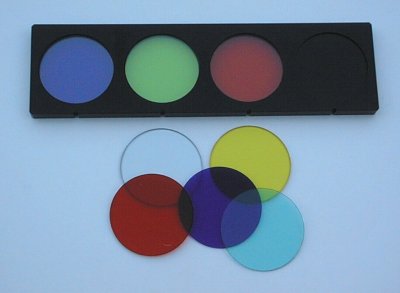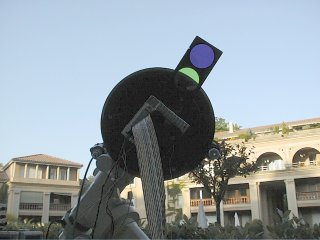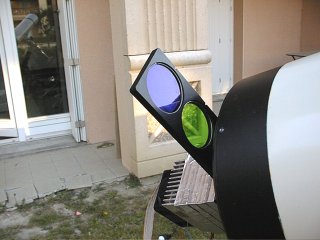
The Audine camera was photometrically calibrated by observing numerous stars in various regions of the sky, referred to as Selected Areas. The magnitude of the selected stars in the RGBI system is readily available from star catalogues. By observing these stars with a telescope fitted with the Audine camera and the appropriate RGBI filters, it is possible to produce the complete spectral characteristics of the camera in a standard photometric reference system. It is important to note that the calibration coefficients described below are only completely valid for the specific observation site used, the elevation of the objects observed relative to the local horizon and to some degree the atmospheric conditions at the time of observation. There is also the potential for significant differences in spectral sensitivity between different KAF-0400 CCD arrays. The coefficients provided should therefore be taken as an approximate indication of the relative performance across the spectrum only.
The Schott filters used for producing the RGBI pass bands were as follows:
|
|
|
|
|
1 mm BG12 + 2 mm GG385 + 1 mm BG18 |
|
|
2 mm GG495 + 1 mm BG18 + 1 mm WG305 |
|
|
2 mm OG570 + 2 mm KG3 |
|
|
3 mm RG9 + 1 mm WG305 |

The observation site used was in the Toulouse suburb of Ramonville Saint-Agne (code UAI 959). The stars were observed at an average elevation of 50 degrees relative to the horizon.
The telescope used was a flat field camera of 190mm, F/D of 4 and a
central obstruction of 0.3. The resulting images were analysed using the
QMiPS32 software. The Audine camera used was a prototype whose characteristics
are very similar to the production model.
 |
 |
The following table gives the signal strength observed as a function of
the filter used, for a G0-spectral-type star (B-G = 0.58, G-R = 0.52, G-I = 0.93) :
|
|
|
|
|
|
|
|
|
|
|
|
|
|
|
|
|
|
|
|
|
|
|
|
The data below define the equations linking the system of magnitudes described above for the equpment, and the magnitudes given in the star catalogues. The instrument magnitudes are based on an image collection cycle of 60s.
b, g, r, i, M are the magnitudes recorded by the instrument
R, G, B, I are the catalogued magnitudes
In 60s, the signal would be 500/2=250 counts. We can now transform this signal into the instrument's magnitude value using Pogson's formula which defines the system of magnitudes:
m = -2.5 log (signal count)
or :
m = -2.5 log (250) = -5.99
We are looking for a magnitude R, and we have m = r = -5.99
From the third equation above, we can write:
R = r + 21.616 + 0.043 (G-R)
or :
R = -5.99 + 21.616 + 0.043 . 0.4 = 15.64
The magnitude R sought is therefore 15.64.
The same star observed in the absence of any filter would give an instrument magnitude as follows for a 60s collection cycle:
M(no filter) = R - 23.197 - 0.033 (G-R) = 15.64 - 23.197 - 0.033 . 0.4 = -7.57
or in terms of signal counts over a 60s collection cycle:
Signal counts = 2.512-M = 2.5127.57 = 1067
The ratio of signal strength without filtering to strength with the R filter is therefore 1067/250=4.27, i.e. the value indicated in the table of relative signal strengths above.
The new Kodak KAF-0401E CCD array shows different characteristics to those above due to a general improvement in the CCD's sensitivity, particularly noticeable in the blue region of the spectrum. This CCD array is compatible with the Audine camera, at the cost of certain minor modifications.
A photometric calibration was performed with an Audine camera equipped with a KAF-0401E, and the results for the R, G, B, I bands for a viewframe of SA101 are now presented:
b, g, r, i, M are the instrument magnitudes
B, G, R, I are the catalogued magitudes
|
|
|
|
|
|
|
|
|
|
|
|
|
|
|
The following table shows the increase in sensitivity of a KAF-0401E
over a KAF-0400 for a star of spectral type G0:
|
|
|
|
|
|
|
|
|
|
|
|
|
|
|
|
|
|
|